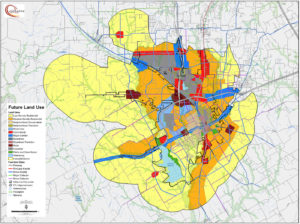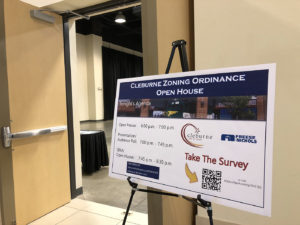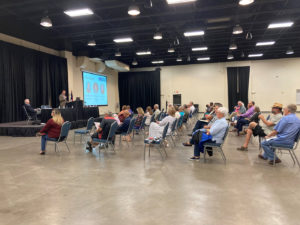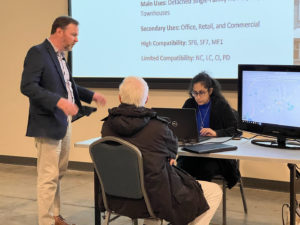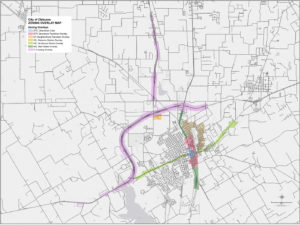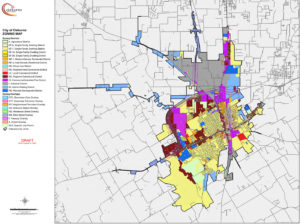Innovation: Cleburne Zoning Ordinance and Future Land Use Plan
The City of Cleburne is a growing community, and its older zoning regulations no longer reflected what the community wanted. As the City was continually receiving requests to rezone property and applications for planning development zoning districts to implement modern development styles, staff recognized that new and infill development within the community signaled a need to update the zoning ordinances and began a two-year long process in early 2020 to update its zoning through an intensive public outreach process.
A diagnostic report was prepared to identify solutions for issues or problems in the City’s current zoning ordinance. The report provided a foundation and framework for the zoning update. The overall total project effort included six open houses, eight public meetings, and five zoning advisory committee meetings, City staff meetings and public hearings.
While updating the zoning ordinance, the City decided that enough growth had occurred, and conditions had changed within Cleburne that the Future Land Use Plan needed to be updated to align the City’s development regulations with the land-use policies. The update was viewed as a critical and immediate need required to provide guidance for the updates to the zoning regulations. The Future Land Use Plan update ensures that the changes reflected current community values.
The City desired a robust community engagement process to review the proposed update to the zoning regulations. The engagement process focused on more than 20,000 direct mailings, social media posts, a dynamic and engaging website with GIS web viewers for the Zoning Map and Future Land Use Map, a dedicated email address for contactless communication with staff, and in-person open houses with one-on-one engagement designed to provide educational and engagement opportunities to residents and businesses. The 2-year project was unanimously approved by City Council with no public opposition in April 2022.
Originality and Transferability
Cleburne’s zoning ordinance and map update focused on educating the community about the new ordinance and how the update would affect the citizens and businesses. A significant feature was the four Educational and Individual Engagement (EIE) Open Houses, in addition to two traditional Open Houses that gathered community input early on. The EIE Open Houses were conducted after the zoning ordinance was drafted and helped educate citizens and businesses regarding proposed changes.
The EIE Open Houses fostered one-on-one conversations between the public and the City’s project team regarding the public’s questions concerning the project. In the meetings, visitors were greeted at the door by project team members and could view educational project boards regarding the changes. Visitors were invited to have individual conversations at tables with a team member to answer property-specific or general questions. At the tables, monitors were arranged so participants could view the zoning map or draft zoning ordinance and ask questions. Conversation times were not limited, and visitors were encouraged to take the time they needed. These stations were also used outside the Council Chambers at public hearings, ensuring no one had to approach the dias to ask a question.
In order to support the efforts of the EIE Open Houses, other tools were used for public outreach. Approximately 3,200 letters were mailed to property owners. Over 19,000 postcards were mailed to all property owners in the City. Facebook and Twitter were used to reach out to individuals online. The City website hosted draft documents and two online GIS viewers, with a total of 3,962 page views and 3,053 unique views.
The EIE Open Houses combined with public outreach tools to further the cause of good planning because they connected the public to the project and offered a high level of transparency with face-to-face conversations.
Effectiveness and Results
The inclusive public outreach program addressed the need for the community to be informed and knowledgeable regarding updates to the Zoning Ordinance, Zoning Map and Future Land Use Plan. The community expressed its need to be informed at an October 2021 Planning and Zoning (P&Z) Commission meeting. After a traditional open house and the City’s diligent efforts to notify the community, the P&Z meeting was well-attended by citizens and business owners seeking more information. Almost everyone who spoke at the meeting had specific questions regarding property or businesses. Because of the fundamental nature of the public’s questions, the project team determined the best method to address these questions was not with regular public hearings or open houses but with Educational and Individual Engagement (EIE) Open Houses that provided a format for the public to obtain the specific information they needed.
The EIE Open Houses included related public outreach efforts, such as letters to property owners, city-wide postcard campaign, social media postings, online web viewers and 8 ½ x 11” summary information handouts with zoning district highlights; these informed citizens about zoning, and how they might be impacted by the changes. The public gained useful and practical knowledge related to how zoning works for them in Cleburne. The project team listened to concerns and questions, provided real-time answers, and put a personal face to a subject that is often difficult to understand, creating a positive effect on the community and the project. For the citizens of Cleburne, their knowledge of zoning and their relationships with the city government was strengthened by the public outreach process. Information was shared broadly with the community, and the community responded both in-person and online. The results were evident as the zoning ordinance was approved unanimously by City Council in April 2022 with zero public opposition.
Engagement
The various public interests were divided into two main categories: those affected by residential zoning district changes and people affected by nonresidential or overlay zoning district changes. The two groups were utilized to better align meeting topics to the audience, but the outreach for both groups was the same. Notably, four Educational and Individual Engagement (EIE) Open Houses were held, two open houses designed for residential zoning districts and two for nonresidential districts.
The project obtained support through various public outreach efforts. Community support was obtained by being responsive and available to the needs of individuals. The one-on-one sessions available to citizens to discuss how zoning impacted their property and livelihood helped garner support for the project. A dedicated email address was also established a contactless way for community members to submit questions directly to staff. The community support led to support from elected and appointed officials.
Input from those who historically were left out of the planning process was sought in cases where rezonings were proposed. The area northeast of downtown has some of the City’s lowest household incomes. Many of these residents responded to the public outreach and attended open houses or submitted emails. The zoning amendments focused on addressing the area’s issues and included innovative solutions to enable property owners to thrive and for new infill development to occur.
Planners played a significant role in every facet of public outreach. Most notably, at the open houses, planners staffed all positions interacting with the public.
There is a direct connection between the public outreach process and the success of the project. Cleburne took the time and effort to inform and engage the community. Because of these efforts, there was public support at the Council hearings because people knew about the project and already had their questions answered.
Support of Planning and Planners
The previous zoning ordinance was last updated in 1996 and was not meeting the community’s needs. This project was undertaken to provide tools for Cleburne’s growth management and ensure future development reflects the community’s stated desires for growth.
But the project was much more than simply a planning exercise. The zoning ordinance project and its public outreach efforts built support for planning and increased understanding of the planning process. The support for planning was demonstrated in how the public and elected officials responded to the project. Public leaders, such as Council and Planning and Zoning Commissioners grew more confident in the project direction after witnessing citizens and businesses respond to the proposed updates through the open houses and the demonstrated level of project transparency. Public leaders became ambassadors of the project, with both Council and P&Z unanimously approving the ordinance. Private individuals began to recognize the need for the project through the open houses, project website, social media posts, and supporting documents created by City staff. Connections between individuals and the City were strengthened as citizens and business owners met with planners. Citizens who were curious about development and the community’s future now had answers and new communication channels with City staff. Stakeholders gained understanding of the process and the vital role they played and can continue to play in not only the adoption of the zoning ordinance but in its implementation and the development of the City’s vision for growth.
Cleburne reached its desired outcome with a community-supported project that addressed critical land development issues, supported the community’s desire for quality development and fulfilled the community’s vision for how it wants to develop.
